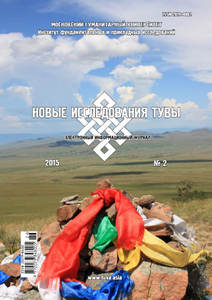Cult places in cultural landscapes of Buryatia and Tuva
Keywords:
Buryatia; Tuva; cult places; cultural landscape; natural and cultural complex; cultural heritage; traditional culture; cult of Obo; cult of srings; temple architecture; mortarAbstract
Article narrates the cult places as integral components of cultural landscapes. It reviews the territories of the Republic of Buryatia and the Republic of Tuva with their various landscapes bearing the heritage of traditional cultures. The special attention is paid to the cult places and attributes having spiritual and religious value for local communities. Potential of their employment as objects for religious and pilgrimage tourism.References
Aleksandrova, N. (2004) Geograficheskoe prostranstvo v kartine mira buddista-palomnika // Chelovek i Priroda v duhovnoj kul'ture Vostoka. M. : IV RAN ; Kraft+. S. 48–78.
Arakchaa, K. D. Slovo ob arzhaanah Tuvy [Jelektronnyj resurs] // Arjaan.narod.ru. URL: http://www.arjaan.narod.ru/indexRus.html (data obrashhenija: 10.03.2015).
Viktorova, L. L. (1980) Mongoly. Proishozhdenie naroda i istoki kul'tury. M. : Nauka.
Gerasimova, K. M. (1969) Kul't obo kak dopolnitel'nyj material dlja izuchenija jetnicheskih processov v Burjatii // Jetnograficheskij sbornik. Vyp. 5. Ulan-Udje.
Dargyn-ool, Ch. K. (2003) Kul'tura kak osnova social'nogo razvitija regionov Rossii (na primere Tuvy) // Gumanitarnye nauki v Sibiri. № 3. S. 40–43.
D'jakonova, V. P. (1977) Religioznye kul'ty tuvincev // Pamjatniki kul'tury narodov Sibiri i Severa. Vyp. 33. L. S. 172–216.
Zhukovskaja, N. L. (1987) Narodnye verovanija mongolov i buddizm // Arheologija i jetnografija Mongolii. Novosibirsk.
Zhukovskaja, N. L. (2013) O buddizme i buddistah. Stat'i raznyh let. 1969–2011. M. : Orientalija.
Zandanova, B. A. (2007) Kul'tovye mesta kak jelementy kul'turnyh landshaftov (na primere nacional'nogo parka «Tunkinskij») : avtoref. diss. … kand. geogr. nauk. Ulan-Udje. 23 s.
Igumnova, M. (2014) Oboo Chingishana v Burjatii hotjat sdelat' mestom palomnichestva turistov [Jelektronnyj resurs] // Bajkal.Djejli. URL: http://www.baikal-daily.ru/news/16/92251/ (data obrashhenija: 10.03.2015).
Kagarov, E. G. (1927) Mongol'skie «obo» i ih jetnograficheskie paralleli // Sbornik Muzeja antropologii i jetnografii Akademii nauk. T. 6. L.
Karruters, D. (1914) Nevedomaja Mongolija. Chast' I. Urjanhajskij kraj. Pg. Lamazhaa, Ch. K. (2011) Tuva mezhdu proshlym i budushhim. 2-e izd. SPb. : Aletejja.
Mongush, M. V. (2010) Indijskaja mozaika. Putevye zametki, interv'ju, vstrechi [Jelektronnyj resurs] // «Novye issledovanija Tuvy». Serija «Special'noe izdanie». 129 s. URL: http://www.tuva.asia/engine/download.php?id=270 (data obrashhenija: 10.03.2015).
Molitvennyj baraban: dar inyh mirov (2005) [Jelektronnyj resurs] // Centr tibetskoj kul'tury i informacii. URL: http://savetibet.ru/2005/09/16/molitvenny_baraban.html (data obrashhenija: 19.03.2015).
Ragulina, M. V. (2004) Kul'turnaja geografija: teorija, metody, regional'nyj sintez. Irkutsk.
Chto takoe oboo v Burjatii (2009) [Jelektronnyj resurs] // Respublika Burjatija, Mongolija, ozero Bajkal. URL: http://buryatia.asia/chto-takoe-oboo-v-buryatii/ (data obrashhenija: 09.03.2015).
Published
How to Cite
Issue
Section

Author(s) license holder(s) grant rights for their work to the journal (grantee of a license) under the simple non-exclusive open license in accordance with Art. 1286.1 «Open license for a research work, work of literature or fine arts», Civil Code of the Russian Federation.
New Research of Tuva publishes articles under the Creative Commons Attribution-NonCommercial license (CC BY-NC).
Since it is an open license, author(s) reserve the right to upload the article to their institutional repository, submit it to another journal (if it allows republications), or republish it on their own website (in full, or in part).
However, several conditions apply here:
a) The republished version must always contain the name(s) and affiliation(s) of the author(s), the original title and the hyperlink to the original version on the New Research of Tuva website;
b) It must be in open access, free of charge, and no category of readers must be in any way whatsoever advantaged over general readership.
c) should the contribution be submitted elsewhere by its author(s) without substantial modification (30% or more of original text unchanged), the body of the article should contain a disclaimer that the original version was published in New Research of Tuva (with a link to the respective page)
The CC-BY-NC is a non-revocable license which applies worldwide and lasts for the duration of the work’s copyright.




